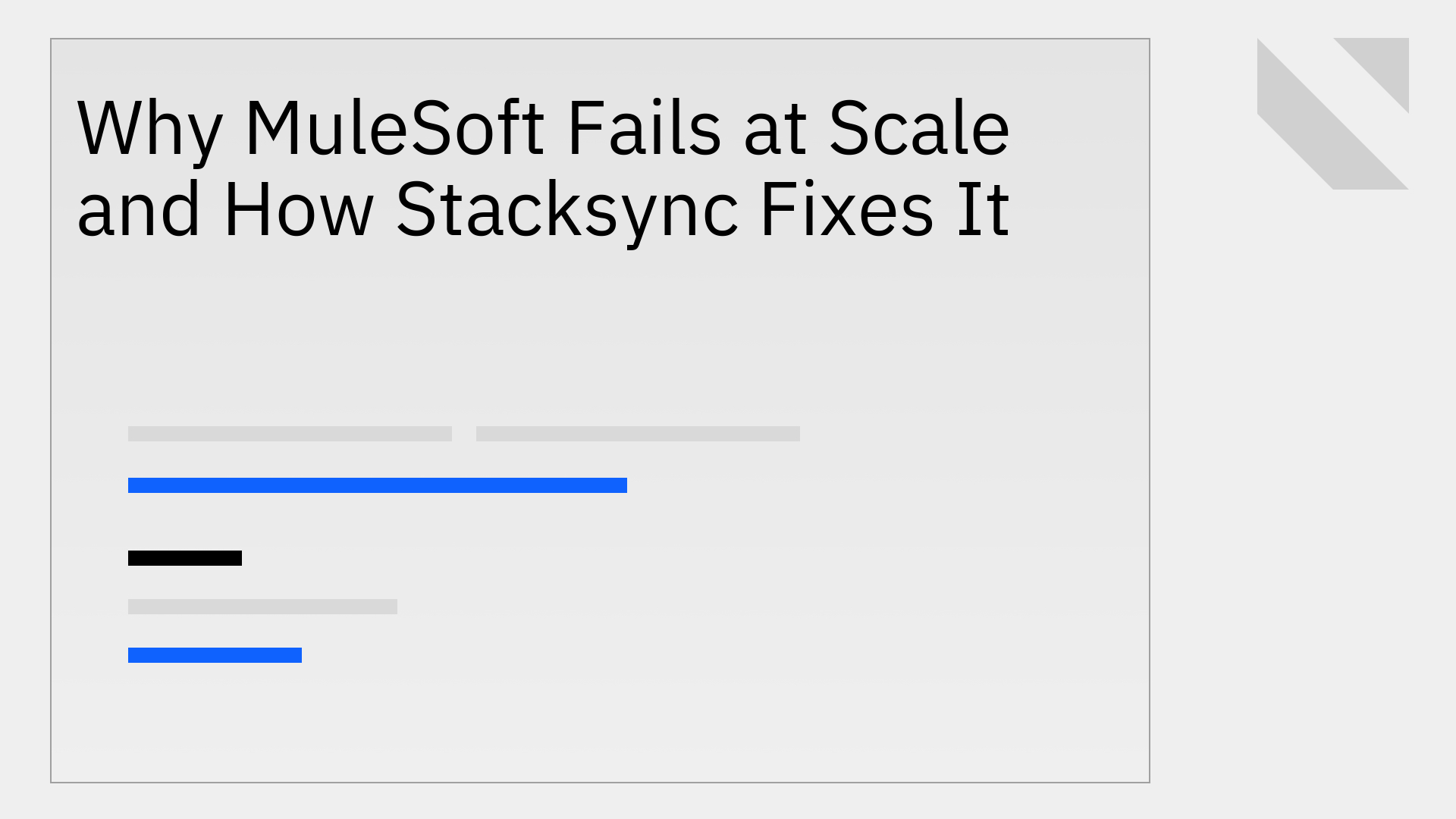
MuleSoft is a widely adopted Integration Platform as a Service (iPaaS) used by enterprises to connect applications and data through its API-led methodology. Its initial appeal lies in creating a network of reusable services, which can be effective for certain integration patterns.
However, as organizations scale, data volumes explode, and the demand for real-time operational consistency becomes paramount, many face significant mulesoft integration challenges. The very architecture that makes MuleSoft a powerful API management tool can become a source of performance bottlenecks, soaring costs, and reliability issues.
For modern, data-driven businesses, these limitations are not just technical inconveniences; they are direct inhibitors of growth. This is where Stacksync, a modern platform purpose-built for high-volume, real-time data synchronization, offers a more scalable, efficient, and cost-effective alternative.
While MuleSoft is a capable tool for orchestrating services and managing APIs, its architecture presents fundamental problems for high-volume, real-time data synchronization. As businesses grow, the need for seamless, instantaneous data flow between critical systems like CRMs (Salesforce, HubSpot), ERPs (NetSuite, SAP), and operational databases becomes non-negotiable. This is where MuleSoft's API-led connectivity model often begins to show cracks, creating friction where there should be flow.
One of the most common mulesoft integration challenges is performance degradation under heavy loads. MuleSoft's architecture, which often relies on scheduled batch jobs or polling APIs, introduces latency that is unacceptable for mission-critical operational workflows. This leads to slow data transfers and delayed updates between systems.
Scaling a MuleSoft environment to meet rising demand is also notoriously complex. Both vertical scaling (adding more CPU/memory to a worker) and horizontal scaling (adding more workers) can be difficult and expensive to manage effectively [6]. Furthermore, MuleSoft’s own CloudHub imposes constraints on its workers, which can quickly become a bottleneck for large-scale deployments and drive up costs without a proportional increase in performance [1]. The platform has documented hard limits on deployments, servers, and properties, which can force complex and costly workarounds as an organization’s integration needs grow [7].
MuleSoft's pricing model is notoriously complex, based on factors like vCores, connectors, and API calls that are difficult to predict and manage. As your data volume and integration needs grow, costs can spiral out of control, leading to a high Total Cost of Ownership (TCO). This financial burden is compounded by the fact that integration challenges are a leading cause of digital transformation failure, with the average cost of a single botched initiative reaching $9.5 million [4].
Beyond licensing, the platform demands a high level of specialized expertise. The scarcity of certified MuleSoft developers means organizations must invest heavily in hiring and retaining talent simply to build, maintain, and troubleshoot their integration flows. This diverts valuable engineering resources away from core product innovation. In contrast, modern platforms offer a more transparent and predictable pricing model.
MuleSoft's core API-led methodology is excellent for creating reusable, discoverable APIs. However, it is fundamentally not optimized for true real-time, two-way data synchronization. Most MuleSoft integrations operate in a "near-real-time" or batch-processing mode, introducing delays that can range from seconds to many minutes.
This inherent latency creates significant business risks. Delayed or one-way data flows lead to data silos, inconsistencies between systems, and ultimately, unreliable business intelligence [2]. When sales, finance, and operations teams are working with conflicting data, decisions become flawed and opportunities are missed. A purpose-built platform designed for real-time integration power is required to solve this core issue.
Stacksync is a modern data sync and workflow automation platform engineered specifically to overcome the scalability, performance, and cost challenges that legacy iPaaS solutions like MuleSoft fail to address. It provides a fundamentally different approach focused on operational data integrity at scale.
Stacksync is built from the ground up for real-time, bidirectional data synchronization, moving data between systems in milliseconds, not minutes. This is not "near-real-time"; it is an event-driven architecture that ensures data consistency is maintained instantly across your entire technology stack.
This purpose-built architecture is why Stacksync outperforms Workato, MuleSoft, Fivetran, and Heroku Connect for operational data synchronization.
Stacksync's modern, cloud-native architecture is designed to scale with your business from day one. You can move from syncing thousands to millions of records without ever having to manage infrastructure, configure vCores, or worry about performance degradation.
Explore our Data Sync & Workflow Automation Platform to see how we remove the complexity of scaling.
One of the biggest pain points with traditional integration tools is the prevalence of "silent sync failures" that corrupt data without warning. Stacksync was designed to provide unparalleled reliability and visibility.
A direct comparison clearly illustrates the advantages of Stacksync for modern, scalable data integration.
While MuleSoft served a purpose in the era of service orchestration, its architecture is fundamentally unsuited for the demands of modern, data-driven enterprises. Companies that require scalable, reliable, and real-time integration are finding that patching together MuleSoft flows is no longer a viable strategy.
Stacksync offers a clear path forward. By providing a platform purpose-built for real-time, bidirectional sync, we empower organizations to eliminate data silos, reduce engineering overhead, and unlock true operational efficiency. It's time to move beyond the limitations of legacy iPaaS. Book a demo to see how Stacksync can solve your integration challenges.